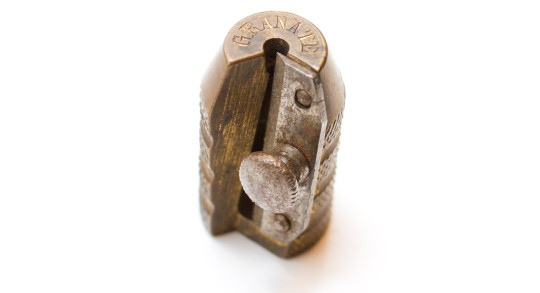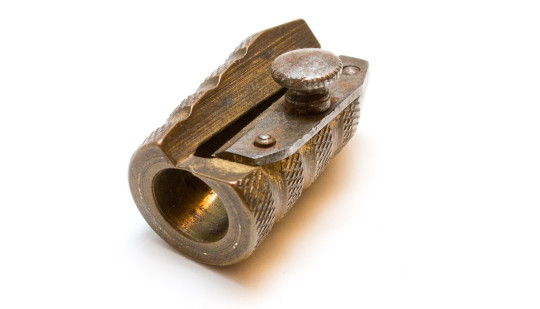…the sharpener called grenade, not a real grenade.
Or should that be ‘How not to restore a grenade’? – you’ll see why.
The age and the name of this sharpener even fit with the current 100th anniversary of Britain’s involvement in WWI, which is being commemorated on a national and on a local level – with local museums and libraries in and around Preston (where I live) taking part.
The grenade sharpener design has been around since 1847 [1]see Lexikaliker: Granate and is still being sold today. I got a modern one, which Lexikaliker got me five years ago when I wasn’t able to get one in the UK.

Cleaning
A few days ago I also got my hands on an old version – I was lucky enough to get one for a good price.
First task: clean it. I bought the metal polish used during a previous trip to Germany, after a tip from Lexikaliker on how to clean old brass.

Problem
Unfortunately something went quite wrong. There was a band of oxidisation after I left the sharpener in the metal polish over night. It now looks as if there’s a dent where this band was. Brass is missing in this dent, which is difficult to see on the photos, but quite obvious in reality.

I have two ideas as to what might have caused this.
- The brass composition was different where this band /dent is, so the polish could ‘erode’ the material there. This explanation seems unlikely.
- I shouldn’t have but the blade and the screw in the same polish. Maybe the metal somehow reacted with the polish which made it ‘corrode’ the brass.
Ok. I got to live with my mistake now, but if I ever get another chance I will keep the blade and screw separate.
Next problem: The blade. It seems slightly too short to cut into the wood. I’ll talk about that another time.

References
| ↑1 | see Lexikaliker: Granate |
|---|
When I used to clean my beloved KUM wedge, I’d make a paste with baking soda and water and use a soft toothbrush to clean some of the gunk. I wasn’t *very* shiny when I was finished, but it was nice and clean. The only issue was that it took a while to get the paste out of the screw hole. 🙂
Has the nameplate turned silver coloured or is that a trick of the light?
Johnny, I should give that a go – if I ever get another chance… I did use a needle to get the paste out of the screw hole.
Sapphire, like you suspected, it’s just the way the light reflects – it’s still brass coloured.
I would suspect hypothesis #1 is more likely than #2. Metal polish is acidic, and metals are not uniform especially alloys used in cheapish goods. Etchy with polish is acually something used by metal sculpture near where a live. Very cool effect when its on purpose.
Stretch, thanks for this information. I didn’t know this is a technique used on purpose. When used on purpose, can it be controlled effectively? I’ll be very careful next time. Managed to get another one for a good price from Germany, but haven’t received it yet.
The artist does it with random purpose, if that makes sense. He uses a brush and sometimes dilutes the polish. But the metal reacts differently and he doesn’t always control the final product.
Good to hear you got a replacement, the vintage sharpener just looks cooler then it’s modern replicas.
Thanks for your comment.
I didn’t know about this way of working with materials, but it sounds as if you’re lucky (or experienced) you can achieve some surprising and fascinating effects.
About my replacement: it arrived yesterday. It’s a Granate 5 (Lexikaliker has a blog post about this model http://www.lexikaliker.de/2012/04/granate-5/ ). Strangely enough mine is lighter than teh other grenades and the surface seems to be removed over time, from polishing or friction – and it looks as if the body is silver coloured. It seems to be too heavy to be aluminium though.. Hmm, very unexpected.
A reader of my weblog recently told me something similar, and we both had the impression that the sharpener was not completely made of brass but coated. Could that also have been the case here?
By the way: My information from back then that the “Granate” dates from 1847 has since turned out to be wrong; it’s from 1890 (see “Der Ursprung der Granate”).